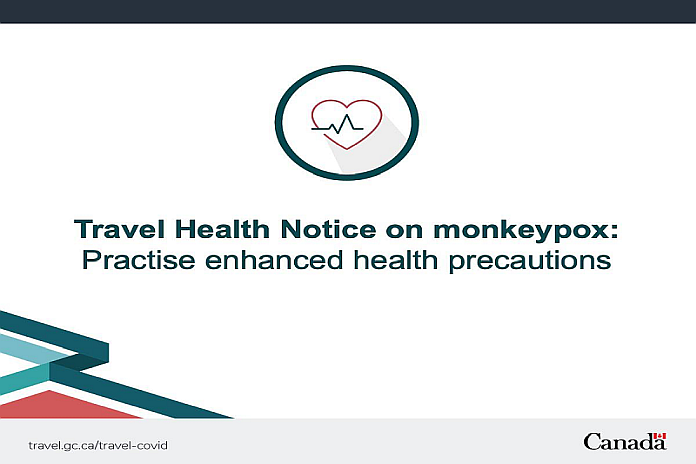– Level 2 – Practise enhanced health precautions (more details)
OTTAWA, Canada – Clusters of monkeypox cases have been reported in several countries internationally, outside of areas in Central and West Africa where cases are normally found. The occurrence of cases with no direct travel to those areas, or without established links to a traveller from those areas, is unusual.
Current situation
In the current outbreak, those at risk of infection are those who have had close or intimate contact with a person who has monkeypox.
During your travel, you may be subject to procedures at your destination put in place to limit the spread of monkeypox, such as isolation, should you become infected. You may have limited access to timely and appropriate health care should you become ill, and may experience delays in returning home.
PHAC is working closely with international, provincial and territorial health partners to gather information on this evolving issue. Further investigations are underway to determine the likely source of infection and to limit further onward spread.
About monkeypox
Monkeypox is a disease that is caused by a virus. It is regurlarly found in parts of Central and West Africa, where it has been re-emerging in recent years. Sporadic cases outside Central and West Africa have been known to occur, usually through infected travellers or transmission from imported animals.
Monkeypox virus can spread in three ways:
- From animals to humans;
- From person to person;
- Through direct contact with contaminated objects.
Monkeypox can spread from person to person through close contact, including in the following ways:
- Contact with an infected person’s:
- Skin lesions or scabs (which may resemble chickenpox);
- Blood or body fluids;
- Mucosal surfaces (such as eyes, mouth, throat, rectum);
- Contaminated clothing or linens, such as bedding and towels, or by sharing personal objects used by an infected person;
- Respiratory droplets (for example: coughs and sneezes) may transmit monkeypox virus, but this is not well understood at this time;
- Contact from:
- Providing care;
- Living in the same household as a case; or,
- Sexual contact.
An infected pregnant person may also pass on the virus to their developing fetus.
Symptoms of monkeypox can begin 5 to 21 days after exposure, and can include:
- Fever – Chills – Swelling of the lymph nodes – Headache – Muscle pain – Joint pain – Back pain – Exhaustion – Appearance of a rash.
It is possible that a rash may be the only presenting symptom. The rash is similar in appearance to chickenpox or other diseases. It often begins on the face or extremities, but can affect other parts of the body, such as the hands, feet, mouth and genitals. The rash changes through different stages before finally forming a scab, which later falls off.
Symptoms usually last between 14 and 28 days. Monkeypox is usually a mild, self-limited disease. In rare situations, people may become very sick and death may occur.
Treatment for monkeypox is mainly supportive. Vaccines and medications for prevention and treatment are not commercially available at this time.
Recommendations
Consult a health care professional or visit a travel health clinic at least 6 weeks before you travel.
You can lower your risk of getting or spreading monkeypox by:
- Delaying your travel and isolating if you have any symptoms of monkeypox, or have been diagnosed with monkeypox
- Practicing respiratory etiquette, including covering coughs and sneezes and wearing a face mask
- Washing your hands frequently with soap and water avoiding close physical contact, including sexual contact, with people who are, or appear to be, sick:
- avoid direct contact with their skin, body fluids, respiratory droplets, or sores on any parts of the body
- avoid contact with their clothing, towels, bedding, or common items that have been contaminated
Be particularly vigilant if you are planning to attend a large party or mass gathering while travelling.





